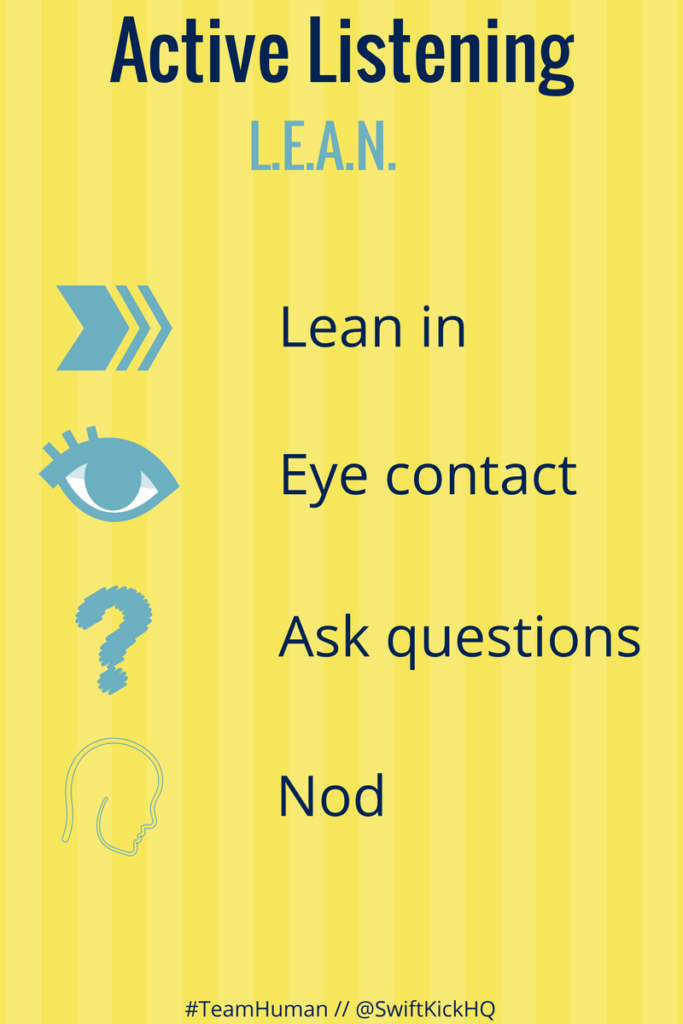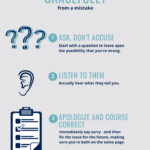I really didn’t know if they were going to hug each other or punch each other.
A couple months ago, I was asked to help mediate a difficult conversation between two team leaders. The two had tried to resolve their differences on their own, but it was clear it was time for a mediator to step in and help come to a resolution.
Within the first meeting, it was obvious to me that the original issue that they were debating was no longer the issue. The real issue was that they both sucked at communicating. What they really needed was a set of communication tools to guide the conversation.
Swift Kick runs a training session called “How to Communicate With Crappy People” where we give leaders, and their teams, tools for more effective communication. The tool this heavyweight duo needed more than anything else was listening. Neither side was actually paying attention to the other person.
The first activity we did was practicing Active Listening. This involved allowing one person to have the floor while the other person could only listen and ask follow-up questions.
A nice way to help remember the steps to Active Listening is a process called LEAN, which I first learned about through Quantum Learning Network.
LEAN IN
Next time you are in a coffee shop, look around at couples who are talking with each other. Someone’s physical body language, alone, can tell you so much about how engaged a person is in the conversation. The physical act of leaning towards the person you are talking to will allow you to hear the person better, and they will also feel like you actually do care about what they’re saying.
EYE CONTACT
You’ve probably heard that eyes are the gateway to the soul. Eyes can also be the gateway to someone’s attention span. If I’m conversing with you but looking elsewhere, I’m only giving you part of my mental computing power.
ASK QUESTIONS
Dale Carnegie was known for saying a person can make a thousand times more friends by being interested rather than interesting. We have two ears and one mouth and should use them in that proportion.
The best way to ask questions is to start by restating something the other person said. Then ask a question related to that restatement. I call it “Snagging The Subject” because the other person will say some kind of noun that will lead to the basis for your question. For example, “You said you grew up in the city in the 60s, what was it like growing up in the city during the 1960s?”
The key is to ask questions that you are actually curious about. Do not do what I call “Leading The Witness.” Leading the Witness is when you ask a question while trying to get the person to say what you want them to say or admit that you’re right. Something like, “Are you sure you didn’t put that paper in the garbage?” You know you are Leading the Witness when you can end your sentence like this: “Are you sure you didn’t put that paper in the garbage…you idiot?”
Asking curious questions while restating what the person just said has three major positive outcomes…
It keeps the conversation going.
It makes the other person feel listened to.
It allows both sides to understand the situation better.
NOD
Have you ever seen a newscaster walk around a city doing on-the-street interviews? They ask a question and then pass the microphone. Before the interviewee even starts talking, the reporter begins to nod their head up and down. They keep nodding during the entire time the other person is speaking. The newscaster is nodding for three major reasons…
It makes the other person feel like everything they are saying is really interesting and important.
It encourages the other person to keep talking.
It makes the other person feel like they are being listened to.
After several rounds of practicing Active Listening with my heavyweight cage match, we applied the technique to their actual issue. It was amazing to watch the transformation from negative escalating emotions to constructive, resolution-focused, conversation. Ultimately, they ended the conversation and both sides agreed to disagree. This happens ALL THE TIME. The biggest difference between this conversation with Active Listening versus one without is that both sides walked away from this conversation feeling better. Both sides felt like the other person heard what they said. So often, just being heard is all either party wants.
In a world that is rapidly changing and pulling us in more directions than ever before, our attention is the best thing we can give to someone else. Try out Active Listening and see how quickly you can turn negative conversations into positive relationships.




